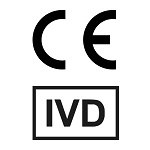Our CCND1/IGH split probe is designed to detect fusions between CCND1 and IGH. To account for the high degree of cross homology in the region containing IGH, part of the IGH portion has been removed. The probe comes labeled in orange and green, but can be customized to meet your needs.
Gene Background: CCND1-IGH fusion is generated by t(11;14)(q13.3;q32.3), which places CCND1 gene next to IGH, resulting in constitutive overexpression of CCND1. The fusion can be found in up to 95% of patients with mantle cell lymphomas (MCL), and is considered the genetic hallmark of this subtype of low-grade peripheral B-cell neoplasms. CCND1-IGH has also been identified in other lymphoproliferative disorders (LPDs), such as B-prolymphocytic leukemia (BLL), and, less frequently, in plasma cell myelomas and B-cell chronic lymphocytic leukemia (CLL).
Source: Bentz JS, et al. (2004) Cancer 102:124-31.
** This product is for in vitro and research use only. This product is not intended for diagnostic use.
Gene Summary
The protein encoded by this gene belongs to the highly conserved cyclin family, whose members are characterized by a dramatic periodicity in protein abundance throughout the cell cycle. Cyclins function as regulators of CDK kinases. Different cyclins exhibit distinct expression and degradation patterns which contribute to the temporal coordination of each mitotic event. This cyclin forms a complex with and functions as a regulatory subunit of CDK4 or CDK6, whose activity is required for cell cycle G1/S transition. This protein has been shown to interact with tumor suppressor protein Rb and the expression of this gene is regulated positively by Rb. Mutations, amplification and overexpression of this gene, which alters cell cycle progression, are observed frequently in a variety of tumors and may contribute to tumorigenesis. [provided by RefSeq, Jul 2008]
Gene Details
Gene Symbol: CCND1
Gene Name: Cyclin D1
Chromosome: CHR11: 69455872-69469242
Locus: 11q13.3




